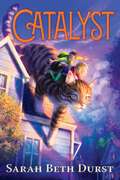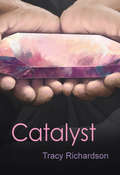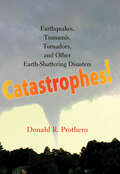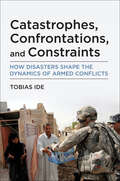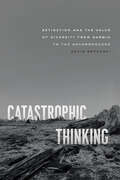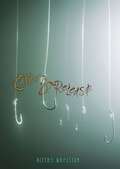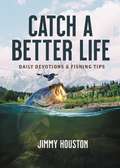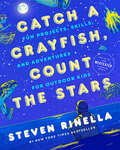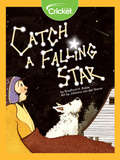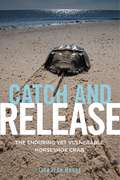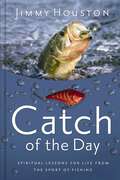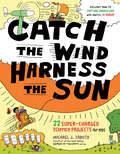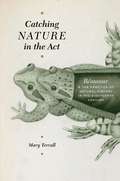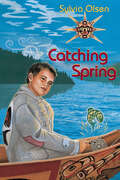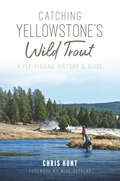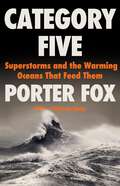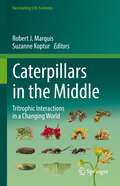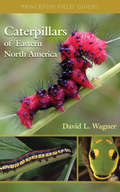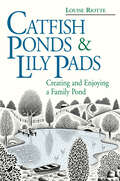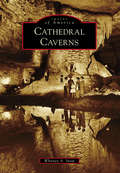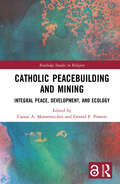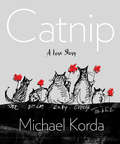- Table View
- List View
Catalyst
by Sarah Beth DurstZoe must figure out how to keep a giant kitten safe in this magical adventure about change, expectation, and accepting all for who they truly are—regardless of shape or size.Zoe named the kitten Pipsqueak, because she was so tiny, and promised to always take care of her. Then the kitten grew. And grew. Now she&’s bigger than a horse—and talking as well! Fleeing into the woods to escape the curious eyes of the Internet, Zoe and her best friend, Harrison, must keep the giant cat hidden as they desperately search for a way to return her to normal size. If they don&’t succeed, Pipsqueak may never be safe again. But why did she grow so large in the first place? And what if trying to change her back leads to even greater danger?
Catalyst (Catalysts #2)
by Tracy RichardsonFor one gifted girl, a summer helping at her mother’s archaeological dig leads to ghosts and a quest to save the planet from destruction.Marcie Horton has a sixth sense. Not in the “I see dead people” way, but . . . well, maybe a little. She feels a sort of knowing about certain things that can’t be explained—an intuition that goes beyond the normal. Then there was that one summer four years ago, when she connected with a long-departed spirit . . . . But nothing that incredible has happened to Marcie since.This summer, Marcie is spending time working at Angel Mounds, the archeological dig her mother heads, along with her brother, Eric, and his girlfriend, Renee. The site was home to an ancient indigenous civilization, and things immediately shift into the paranormal when Marcie and her dig teammates meet Lorraine and Zeke. The two mysterious dig assistants reveal their abilities to access the Universal Energy Field with their minds—something Marcie knows only vaguely that her brother has also had experience with.Marcie learns how our planet will disintegrate if action is not taken, and she and her team must decide if they are brave enough to help Lorraine and Zeke in their plan to save Mother Earth, her resources, and her history.It looks like the summer just got a lot more interesting . . . Praise for Catalyst“Tracy Richardson has created an intriguing premise that blends the worlds of sci-fi, spiritualism, and climate activism.” —Allen Johnson, screenwriter, The Freemason“An ode to the responsibility of taking care of our one and only Earth, Catalyst offers an energetic and immersive experience that spotlights alternate dimensions, energy fields, and our very own human potential.” —Genese Davis, game writer, author of The Holder’s Dominion series
Catastrophes!: Earthquakes, Tsunamis, Tornadoes, and Other Earth-Shattering Disasters
by Donald R. ProtheroDevastating natural disasters have profoundly shaped human history, leaving us with a respect for the mighty power of the earth—and a humbling view of our future. Paleontologist and geologist Donald R. Prothero tells the harrowing human stories behind these catastrophic events.Prothero describes in gripping detail some of the most important natural disasters in history:• the New Madrid, Missouri, earthquakes of 1811–1812 that caused church bells to ring in Boston• the 2004 Indian Ocean tsunami that killed more than 230,000 people• the massive volcanic eruptions of Krakatau, Mount Tambora, Mount Vesuvius, Mount St. Helens, and Nevado del RuizHis clear and straightforward explanations of the forces that caused these disasters accompany gut-wrenching accounts of terrifying human experiences and a staggering loss of human life. Floods that wash out whole regions, earthquakes that level a single country, hurricanes that destroy everything in their path—all are here to remind us of how little control we have over the natural world. Dramatic photographs and eyewitness accounts recall the devastation wrought by these events, and the people—both heroes and fools—that are caught up in the earth's relentless forces. Eerie, fascinating, and often moving, these tales of geologic history and human fortitude and folly will stay with you long after you put the book down.
Catastrophes, Confrontations, and Constraints: How Disasters Shape the Dynamics of Armed Conflicts
by Tobias IdeA ground-breaking study on how natural disasters can escalate or defuse wars, insurgencies, and other strife.Armed conflict and natural disasters have plagued the twenty-first century. Not since the end of World War II has the number of armed conflicts been higher. At the same time, natural disasters have increased in frequency and intensity over the past two decades, their impacts worsened by climate change, urbanization, and persistent social and economic inequalities. Providing the first comprehensive analysis of the interplay between natural disasters and armed conflict, Catastrophes, Confrontations, and Constraints explores the extent to which disasters facilitate the escalation or abatement of armed conflicts—as well as the ways and contexts in which combatants exploit these catastrophes.Tobias Ide utilizes both qualitative insights and quantitative data to explain the link between disasters and the (de-)escalation of armed conflict and presents over thirty case studies of earthquakes, droughts, floods, and storms in Africa, the Middle East, Asia, and Latin America. He also examines the impact of COVID-19 on armed conflicts in Iraq, Afghanistan, Nigeria, and the Philippines.Catastrophes, Confrontations, and Constraints is an invaluable addition to current debates on climate change, environmental stress, and security. Professionals and students will greatly appreciate the wealth of timely data it provides for their own investigations.
Catastrophic Events Student Guide and Source Book (2nd Edition)
by Carol O’donnellThis edition of student guide and source book on Catastrophic Events contains three parts viz., Storms, Earthquakes and Volcanoes. Also included are Glossary, Index, Photo Credits and Selected References.
Catastrophic Thinking: Extinction and the Value of Diversity from Darwin to the Anthropocene (science.culture)
by David SepkoskiA history of scientific ideas about extinction that explains why we learned to value diversity as a precious resource at the same time as we learned to “think catastrophically” about extinction. We live in an age in which we are repeatedly reminded—by scientists, by the media, by popular culture—of the looming threat of mass extinction. We’re told that human activity is currently producing a sixth mass extinction, perhaps of even greater magnitude than the five previous geological catastrophes that drastically altered life on Earth. Indeed, there is a very real concern that the human species may itself be poised to go the way of the dinosaurs, victims of the most recent mass extinction some 65 million years ago. How we interpret the causes and consequences of extinction and their ensuing moral imperatives is deeply embedded in the cultural values of any given historical moment. And, as David Sepkoski reveals, the history of scientific ideas about extinction over the past two hundred years—as both a past and a current process—is implicated in major changes in the way Western society has approached biological and cultural diversity. It seems self-evident to most of us that diverse ecosystems and societies are intrinsically valuable, but the current fascination with diversity is a relatively recent phenomenon. In fact, the way we value diversity depends crucially on our sense that it is precarious—that it is something actively threatened, and that its loss could have profound consequences. In Catastrophic Thinking, Sepkoski uncovers how and why we learned to value diversity as a precious resource at the same time as we learned to think catastrophically about extinction.
Catch & Release (Carolrhoda Ya Ser.)
by Blythe WoolstonI should have died quick. But I didn't. I'm a miracle of modern medicine, only the medicine doesn't get much credit, I notice. People say I'm lucky, or I'm blessed, and then they turn away. I'm not the only miracle. There's Odd too. Polly Furnas had The Plan for the future. Get married to Bridger Morgan, for one. College, career, babies. Etc. All the important choices were made. It was all happily-ever-after as a diamond-ring commercial. But The Plan did not include a lethal drug-resistant infection. It did not include “some more reconstruction and scar revision in the future." And it certainly did not include Odd Estes, a trip to Portland in an ancient Cadillac to "tear Bridger a new one," fly fishing, marshmallows, Crisco, or a loaded gun. But plans change. Stories get revised and new choices must be made. Polly and Odd have choices. Surviving or not. Catch or release.
Catch a Better Life: (A 365-Day Devotional) – Perfect Christian Men and Women Who Love to Fish
by Jimmy HoustonBass fishing pro Jimmy Houston gives outdoor enthusiasts from beginners to bassmasters spiritual insights and fishing tips in this yearlong devotional.What does a fishing lure have to do with following Jesus? How can casting our lines remind us of our commitment to godly living? In what ways does the underwater world teach us about God's purposes? In Catch a Better Life, hugely popular pro fisherman Jimmy Houston shares wisdom from the Bible along with plenty of savvy fishing advice. Each entry in this 365-day devotional includes:A Scripture verse from the Old or New TestamentA brief meditation that applies insights from the art of fishing to spiritual growthA pro fishing tip With its colorful photos and a presentation page, this full-color book makes a perfect gift for:The outdoor enthusiastAnyone who loves to fish or wants to learnFollowers of Jimmy Houston as TV host and fisher extraordinaireRetirement parties, Father's Day, Grandparents' Day, birthdays, Christmas If you love God's creation--along with the excitement of the catch--and want to grow in your spiritual life, reel in this fisherman's devotional guide to following God with purpose.
Catch a Crayfish, Count the Stars: Fun Projects, Skills, and Adventures for Outdoor Kids
by Steven RinellaA hands-on, gloves-off, muddy-boots activity book for young adventurers ages eight and up, offering fun projects and adventures to build lifelong skills and knowledge about the natural world—from the host of MeatEater and the New York Times bestselling author of The MeatEater Guide to Wilderness Skills and Survival <p><p> Does climbing a tree, building a bug hotel, spearing a bullfrog, stalking wild animals, and scouting for petrified wood sound more fun than homework or chores? If so, this guide is your perfect companion to endless summer days and rainy fall afternoons alike. Filled with advice, insights, and activities to inspire wonder and excitement about the natural world, Catch a Crayfish, Count the Stars is a curious kid’s treasure trove, filled to the brim with outdoor projects, skills, and adventures complete with illustrations. The book presents a ton of fun and exciting ways to explore the natural world, like <p>• building an outdoor exploration kit <p>• identifying constellations and navigating using the sun and stars <p>• collecting fossils and other geological wonders <p>• tracking animals and following weather patterns <p>• making your own compass <p>• growing your own fruits and vegetables <p>• building survival shelters and primitive hunting weapons <p>• fishing, hunting, and foraging for wild foods <p>• making cool art projects using natural materials <p><p> A must-have guide for budding naturalists, scientists, gardeners, anglers, foragers, and hunters, Catch a Crayfish, Count the Stars helps get kids out into nature, imparting lifelong knowledge and skills along the way. <p> <b>New York Times Bestseller</b>
Catch a Falling Star
by Bradford H. RobieAnna must wake up late and struggle to keep warm outside so she can watch a meteor shower.
Catch and Release: The Enduring Yet Vulnerable Horseshoe Crab
by Lisa Jean MooreThe unexpected and fascinating interspecies relationship between humans and horseshoe crabs.Horseshoe crabs are considered both a prehistoric and indicator species. They have not changed in tens of millions of years and provide useful data to scientists who monitor the health of the environment. From the pharmaceutical industry to paleontologists to the fishing industry, the horseshoe crab has made vast, but largely unknown, contributions to human life and our shared ecosystem. Catch and Release examines how these intersections steer the trajectory of both species’ lives, and futures. Based on interviews with conservationists, field biologists, ecologists, and paleontologists over three years of fieldwork on urban beaches, noted ethnographer Lisa Jean Moore shows how humans literally harvest the life out of the horseshoe crabs. We use them as markers for understanding geologic time, collect them for agricultural fertilizer, and eat them as delicacies, capture them as bait, then rescue them for conservation, and categorize them as endangered. The book details the biomedical bleeding of crabs; how they are caught, drained of 40% of their blood, and then released back into their habitat. The model of catch and release is essential. Horseshoe crabs cannot be bred in captivity and can only survive in their own ecosystems. Moore shows how horseshoe crabs are used as an exploitable resource, and are now considered a “vulnerable” species.An investigation of how humans approach animals that are essential for their survival, Catch and Release questions whether humans should have divine, moral, or ethical claims to any living being in their path.
Catch of the Day: Spiritual Lessons for Life from the Sport of Fishing (A 365-Day Devotional) – Perfect Christian Men and Women Who Love to Fish
by Jimmy HoustonFishermen don&’t rely on luck in order to catch fish—they put their skills, knowledge, and experience into play every time they cast their line. Likewise, righteous and godly living doesn&’t come naturally but requires study, commitment, and a lot of practice. In Catch of the Day, Jimmy Houston combines his love of fishing and his love of God in this unique fisherman&’s 365-day devotional. Each day features:A meaningful ScriptureA daily devotional that incorporates a thought for meditation which applies insights from the art of fishing to daily spiritual growthA fishing tip from bassmaster, Jimmy Houston With colorful interiors and a ribbon marker, Catch of the Day is a great gift for:Birthdays, Father&’s Day, and ChristmasGrandparents Day or as an encouragement boost for an outdoors enthusiast needing a lift Put into action the characteristics needed to be a great fisherman, and see how they can also make you into a great fisher of men. Anyone who loves God&’s creation, combined with the excitement of the catch, will truly enjoy this yearlong guide of spiritual lessons for life.
Catch the Wind, Harness the Sun: 22 Super-Charged Projects for Kids
by Michael J. CadutoGet charged up about energy! With more than 20 fun activities and experiments that will have children ages 8 to 12 enthusiastically engaged with making and using renewable energy, Michael J. Caduto takes a hands-on approach to fighting climate change. Step-by-step instructions for projects range from using the sun to make fires to charging electronic devices by peddling your bicycle. Additional energy case studies encourage kids to think about the basic tenets of resource management. Change the world — one miniature windmill at a time.
Catching Fog // Making Rain (Fountas & Pinnell LLI Purple #Level S)
by Sarah BrockettProvides information about increasing water supply.
Catching Nature in the Act: Réaumur and the Practice of Natural History in the Eighteenth Century
by Mary TerrallNatural history in the eighteenth century was many things to many people--diversion, obsession, medically or economically useful knowledge, spectacle, evidence for God’s providence and wisdom, or even the foundation of all natural knowledge. Because natural history was pursued by such a variety of people around the globe, with practitioners sharing neither methods nor training, it has been characterized as a science of straightforward description, devoted to amassing observations as the raw material for classification and thus fundamentally distinct from experimental physical science. In Catching Nature in the Act, Mary Terrall revises this picture, revealing how eighteenth-century natural historians incorporated various experimental techniques and strategies into their practice. At the center of Terrall’s study is René-Antoine Ferchault de Réaumur (1683-1757)--the definitive authority on natural history in the middle decades of the eighteenth century--and his many correspondents, assistants, and collaborators. Through a close examination of Réaumur’s publications, papers, and letters, Terrall reconstructs the working relationships among these naturalists and shows how observing, collecting, and experimenting fit into their daily lives. Essential reading for historians of science and early modern Europe, Catching Nature in the Act defines and excavates a dynamic field of francophone natural history that has been inadequately mined and understood to date.
Catching Spring (Orca Young Readers)
by Sylvia OlsenThe year is 1957, and Bobby lives on the Tsartlip First Nation reserve on Vancouver Island where his family has lived for generations and generations. Bobby loves his weekend job at the nearby marina. He loves to play marbles with his friends. And he loves being able to give half his weekly earnings to his mother to eke out the grocery money, but he longs to enter the up-coming fishing derby. With the help of his uncle and Dan from the marina his wish just might come true.
Catching Yellowstone's Wild Trout: A Fly-Fishing History and Guide (Natural History)
by Chris HuntThis history and guide to the fly-fishing waters of Yellowstone National Park is a loving homage to the region&’s iconic wild trout. Yellowstone National Park is home to some of the most storied destinations in the history of fly fishing. Casting in the Firehole River is like going back in time to when bison roamed nearly every meadow in the West. Restored to their natal streams after near extinction, native Arctic grayling can once again be plucked from icy water at the foot of breathtaking waterfalls. Meanwhile, a daylong hike into true wild country rewards an angler with a chance to catch trophy native cutthroat trout on a lonely mountain lake. In Catching Yellowstone&’s Wild Trout, local journalist and experienced angler Chris Hunt explores the rich history of these beloved and bountiful waters.</
Category Five: Superstorms and the Warming Oceans That Feed Them
by Porter FoxSuperstorms, hurricanes, typhoons, and spiraling freak weather: the fallout of global warming is a real-life natural thriller, as captured in Porter Fox&’s urgent and stunning story of chasing the world&’s most devastating storms. Here is the story of the largest storms on earth and how those storms are growing bigger and stronger. The tale of extreme weather doesn&’t begin with floods, fires, or even the air that carries this change to our lives. It begins with the ocean. Oceans create weather, climate, floods, droughts, and most of the geophysical fallout of global warming. Exactly how, award-winning writer Porter Fox contends, depends on invisible ocean currents, planetary cycles just now being defined, and processes in the deep ocean that may well have already saved us from the worst effects of the climate crisis. In an attempt to avert a coming age of superstorms, sea level rise, and catastrophic warming, scientists followed the lead of a college drop-out-turned-maverick sailor and storm-chaser; a Romanian refugee turned BBC radio host turned circumnavigating mapmaker; and an audacious new attempt to study storms above as well as deep below the ocean depths, using drones. Throughout Category Five, Fox shadows these explorers, scientists, oceanographers, and weather forecasters in an attempt to understand, forestall, and possibly harness the awesome power of our oceans.
Caterpillars in the Middle: Tritrophic Interactions in a Changing World (Fascinating Life Sciences)
by Robert J. Marquis Suzanne KopturCaterpillars are excellent model organisms for understanding how multiple selective forces shape the ecology and evolution of insects, and organisms in general. Recent research using the tools of modern molecular biology, genetics, metabolomics, microbial ecology, experiments conducted at a global level, network analysis, and statistical analyses of global data sets, combined with basic natural history, are yielding exciting new insights into caterpillar adaptations and ecology. The best way to view these research advances is within a framework of tri-trophic interactions. This is a timely topic for research given the central role of caterpillars and plants in the ecology and trophic structure of terrestrial communities. This book is unique in that it contains chapters from a team of experts on a diversity of key topics within caterpillar-plant interactions. This volume brings together contributions by researchers from around the globe, working in both tropical and temperate habitats, and in human-managed and more natural habitats. It is a significant contribution to our understanding of insect biology, and the role that insects, as represented by caterpillars, play in a world increasingly dominated by humans and one in which threats to insect biodiversity are mounting.Chapter 11 is available open access under a Creative Commons Attribution 4.0 International License via link.springer.com.
Caterpillars of Eastern North America: A Guide to Identification and Natural History (Princeton Field Guides #36)
by David WagnerThis lavishly illustrated guide will enable you to identify the caterpillars of nearly 700 butterflies and moths found east of the Mississippi. The more than 1,200 color photographs and two dozen line drawings include numerous exceptionally striking images. The giant silk moths, tiger moths, and many other species covered include forest pests, common garden guests, economically important species, and of course, the Mescal Worm and Mexican Jumping Bean caterpillars. Full-page species accounts cover almost 400 species, with up to six images per species including an image of the adult plus succinct text with information on distribution, seasonal activity, foodplants, and life history. These accounts are generously complemented with additional images of earlier instars, closely related species, noteworthy behaviors, and other intriguing aspects of caterpillar biology. Many caterpillars are illustrated here for the first time. Dozens of new foodplant records are presented and erroneous records are corrected. The book provides considerable information on the distribution, biology, and taxonomy of caterpillars beyond that available in other popular works on Eastern butterflies and moths. The introductory chapter covers caterpillar structure, life cycles, rearing, natural enemies, photography, and conservation. The section titled "Caterpillar Projects" will be of special interest to educators. Given the dearth of accessible guides on the identification and natural history of caterpillars, Caterpillars of Eastern North America is a must for entomologists and museum curators, forest managers, conservation biologists and others who seek a compact, easy-to-use guide to the caterpillars of this vast region. A compact guide to nearly 700 caterpillars east of the Mississippi, from forest pests to garden guests and economically important species 1,200 color photos and 24 line drawings enable easy identification Full-page species accounts with image of adult insect for almost 400 species, plus succinct text on distribution and other vital information Many caterpillars illustrated here for the first time Current information on distribution, biology, and taxonomy not found in other popular works A section geared toward educators, "Caterpillar Projects" An indispensable resource for all who seek an easy-to-use guide to the caterpillars of this vast region
Catfish Ponds & Lily Pads: Creating and Enjoying a Family Pond
by Louise RiotteIn this entertaining guide, Louise Riotte tells you everything you need to know to create a productive pond on your own land, from siting the pond to maintaining water quality and stocking the pond with fish. She also includes plenty of old-time fishing lore and scrumptious recipes for freshly caught fish.
Cathedral Caverns (Images of America)
by Whitney A. SnowIn 1952, Jacob “Jay” Gurley explored a Marshall County, Alabama, curiosity known as Bat Cave. Amazed by its stalagmites and sheer enormity, he purchased the site and began transforming it into Cathedral Caverns, a spectacular tourist attraction that eventually became a national natural landmark in 1973 and a state park in 2000. Had it not been for Gurley’s hard work and dedication, this cave, a geological treasure of international renown, might have remained a little-known hole in the ground. His efforts impacted local and state tourism, economics, and politics. This is the story of one man and his vision.
Catholic Peacebuilding and Mining: Integral Peace, Development, and Ecology (Routledge Studies in Religion)
by Caesar A. MontevecchioThis book explores the role of Catholic peacebuilding in addressing the global mining industry. Mining is intimately linked to issues of conflict, human rights, sustainable development, governance, and environmental justice. As an institution of significant scope and scale with a large network of actors at all levels and substantial theoretical and ethical resources, the Catholic Church is well positioned to acknowledge the essential role of mining, while challenging unethical and harmful practices, and promoting integral peace, development, and ecology. Drawing together theology, ethics, and praxis, the volume reflects the diversity of Catholic action on mining and the importance of an integrated approach. It includes contributions by an international and interdisciplinary range of scholars and practitioners. They examine Catholic action on mining in El Salvador, Peru, Colombia, the Democratic Republic of the Congo, and the Philippines. They also address general issues of corporate social responsibility, human rights, development, ecology, and peacebuilding. The book will be of interest to scholars of theology, social ethics, and Catholic studies as well as those specializing in development, ecology, human rights, and peace studies.
Catnip: A Love Story
by Michael KordaFrom silly to sweet, 365 cat sketches by Michael Korda, drawn with love for his wife With the imagination of a writer and the eye of an artist, Michael Korda doodled on the backs of old manuscripts in his tackroom while his wife, Margaret, was out riding. They loved and acquired cats—a habit written about previously in their book, Cat People—and the few in residence at this time would serve as inspiration for the drawings. These are no ordinary cat illustrations, though. Korda’s cats read newspapers and books; go ice skating in the small country town where they live; comfort Margaret’s horse, Monty, after a stressful vet visit; sell fried mice at the Farmer’s Market, and undertake (on paper, at least) whatever fanciful endeavors their keeper conjures up. The result is a collection of magical pieces, filled with joy, that represent a year in the life of a couple in love with one another, and certainly with their cats.
